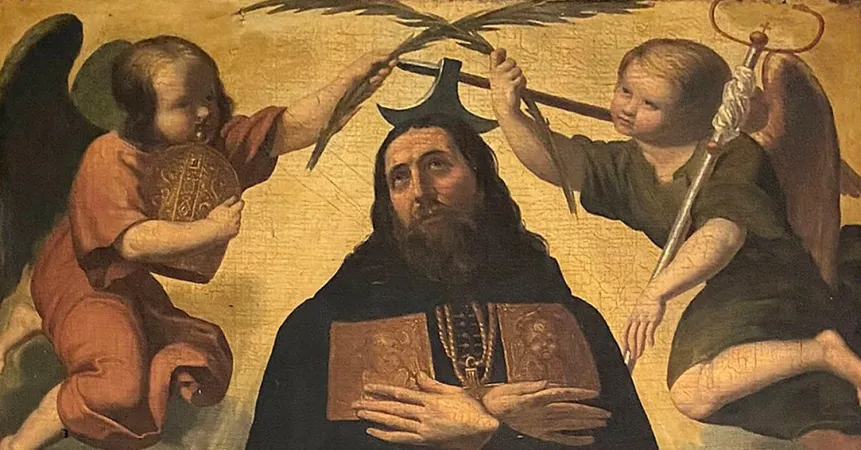
A special moment for the Gregorian University, which, starting this evening, is hosting "The exhibition 'May they all be one' (Jn 17:21). The 400th Anniversary of the Martyrdom of Saint Josaphat Kuncewycz."
The exhibition is dedicated to the anniversary of the martyrdom of Saint Josaphat Kuncewycz (ca. 1580-1623), the apostle of Christian unity. Saint Josaphat, monk of the Order of Saint Basil the Great, dedicated his life to pursuing unity among Christians. The life and works of the saint of the Eastern Rite Catholic Church embrace Lithuania, Ukraine, Poland, and Belarus, testifying to the historical ties of the Catholic Church of the Eastern Rite with Western Europe and, in particular, with Rome as its spiritual home. In 1623, Saint Josaphat was martyred in Vitebsk. In 1643, he was beatified, and in 1867, he was canonized.
Ivan Kuncewycz was born around 1580 in Volodymyr, Volhynia, in present-day Ukraine. As a young man, he moved to Vilnius (Lithuania), where, according to his father's intentions, he was meant to learn the trade of a merchant. In 1604, he entered the monastery of the Holy Trinity of Vilnius, which was already in communion with Rome, assuming the name of Josaphat. In 1617, together with the Metropolitan of Kyiv, Joseph Velamin Rutskyj (1574-1637), he founded the Order of Saint Basil the Great. He transformed the contemplative form of monastic life into intense spiritual edification, promoting an order of educated monks engaged in intense pastoral and missionary activity, taking the Order of Discalced Carmelites and the Society of Jesus as a model.
After being appointed Archbishop of Polock in 1618, Josaphat Kuncewycz attracted the ire of his adversaries due to his tireless activity. Threats arose against him. In 1623, in Vitebsk, threats turned into actions: on November 12, after his morning Mass, the Archbishop was attacked and killed by a furious crowd. The same year, he was buried in the Cathedral of St. Sophia in Polotsk, and his tomb soon became a place of pilgrimage and grace. During the wars of the 17th century against Moscow, to prevent the Muscovite army from destroying them, the relics of the martyr were transferred from Polock and temporarily hidden in safer places. In 1667, the body of the former Archbishop was transferred to the monastery of the Holy Trinity of Vilnius for a short time.
In 1705, the relics of Blessed Josaphat were again transferred from Polock and were never returned; they were kept in the city of Biała (in present-day Poland). While they were there in 1867, Pope Pius IX proclaimed Blessed Josaphat a saint. In 1873, the Russian army removed the relics from their altar and were hidden under the church floor, where they remained until 1915. In 1916, the remains of St. Josaphat were transferred to Vienna to the church of St. Barbara. In 1949, the saint's relics were transferred to Rome under the protection of Giovanni Battista Montini, the future Pope Paul VI. Since November 25, 1963, by the will of Pope John XXIII, the body of Saint Josaphat Kuncewycz has rested under the altar of Saint Basil the Great in Saint Peter's Basilica.
The exhibition presents the history of the cult and image of Saint Josaphat: the paintings, books, and engravings of the Holy Martyr. For the first time, the canonical image of Saint Josaphat Kuncewycz (1867), painted for the canonization ceremony, is publicly exhibited, as is a recently rediscovered portrait of Saint Josaphat attributed to the painter Sebastiano Conca (1680-1764).
The exhibition is curated by Sigita Maslauskaitė-Mažylienė and is organized by the Embassy of the Republic of Lithuania to the Holy See. The S.M. Order of Malta has the patronage of the President of the Parliament of the Republic of Lithuania, Viktorija Čmilytė-Nielsen, of the Metropolitan Archbishop of Vilnius Gintaras Grušas, of the Major Archbishop of the Ukrainian Greek-Catholic Church Sviatoslav Shevchuk. And also of the Pontifical Gregorian University, the General Curia of the Basilian Order of Saint Josaphat, the Pontifical Ukrainian College of Saint Josaphat, the Abbey of Saint Nilo of Grottaferrata, the Museum of Historical Heritage of the Church of Vilnius, and the Ukrainian Catholic University.
The exhibition will be inaugurated this evening by Cardinal Kurt Koch, Prefect of the Dicastery for Promoting Christian Unity, by Fr. Mark Andrew Lewis. S.J., Rector of the Pontifical Gregorian University; Gintaras Grušas, Metropolitan Archbishop of Vilnius; Sviatoslav Shevchuk, Major Archbishop of the Ukrainian Greek Catholic Church; Sigita Maslauskaitė-Mažylienė, Ambassador of the Republic of Lithuania to the Holy See; Fr. Robert Roman Lisseiko, OSBM, Protoarchimandrite - Superior General of the Basilian Order of Saint Josaphat; Fr. Francesco De Feo, O.S.B., Hegumen of the Abbey of San Nilo in Grottaferrata; Ottavio Bucarelli, Director of the Department of Cultural Heritage of the Church, Faculty of History and Cultural Heritage of the Church, Pontifical Gregorian University.
Translated and adapted by Jacob Stein.
These article was originally published on ACI Stampa.







